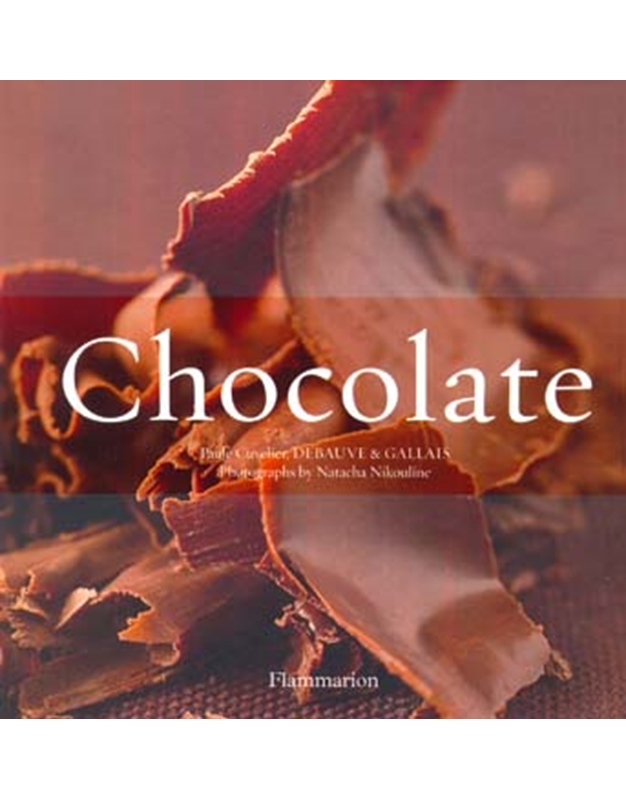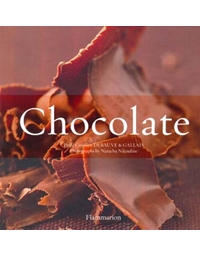- 6 Aτοκες

Chocolate (The History of Chocolate - The Taste of Chocolate)
Yet chocolate was slow to reach France and if it had not been for the marriage between Louis XIV and the Spanish infanta it may well have remained still longer on the other side of the Pyrenees, jealously guarded by the descendants of Ferdinand and Isabella. As a husband, Louis XIV was a fortunate man. Though the premature death of his wife Maria Theresa must have brought him great sorrow, he had much to be grateful for—not least the fact that he was the first king of France to appoint a chocolatier du Roi—a royal chocolate maker. This was David Chaillou, a distant forebear of Sulpice Debauve, the next in this story to hold the title, more than a century later. But the Sun King was more attracted by the female sex and by splendor than he was by chocolate! When winter came and the austere Madame de Maintenon took the place of the spirited Madame de Montespan, chocolate disappeared from the royal court.
But chocolate had acquired a reputation of distinction outside the court. It flourished, its cost making it a luxury item enjoyed by the aristocracy and a feature of the French 'art of living' which, during the eighteenth century, became the lifestyle to which all the European aristocracies aspired. Generations of craftsmen made their own unique contribution to the processing of the cocoa beans and the preparation of a beverage, which, though perhaps less energizing than the 'drink of the gods' (Carolus Linnaeus' Theobroma), was far better suited to the refined palates of Europe! To these artisans, chocolate owes a great debt.
Delicious but high in calories, chocolate is very much an energy food, the exact composition of which varies according to its provenance and method of manufacture. Dark chocolate, for instance, at 5 15 calories per 14 lb (100 g), contains many hundreds of different molecules, 60 percent of them in the form of carbohydrates, 30 percent in the form of fats, and 5 percent in the form of proteins. The carbohydrates present in the bean starch and the added sugars are assimilated differently by the body depending on the addition of almonds, hazelnuts, or other grains. The highest proportion of starch is in fact found in the unsweetened cocoa powder As the addition of sugar is detrimental to the cocoa content, it is preferable to consume chocolate in its 'raw state,' given that sorbitol-type sweeteners only reduce the energy value by 15 percent. The fats associated with the fiber content give chocolate a glycemic index similar to that of dried vegetables or wholemeal bread. Milk chocolate is slightly higher in calories than dark chocolate at 540 calories per % lb (100 g). Rich in mineral salts (calcium, magnesium, phosphorus, potassium, and sodium), chocolate also contains many vitamins (A, BI, B2, B3, BI2, and D), trace elements (iron, copper), and substances with stimulant properties including theobromine, an alkaloid similar to caffeine. Also worth noting is the presence of polyphenols, whose anti-oxidant and anti-coagulant properties make it valuable in the prevention of cardiovascular problems.
Contrary to conventional wisdom, chocolate does not increase cholesterol levels. On the contrary, the presence of phytosterols reduces absorption of cholesterol in the small intestine...
- ItemId: 180244
- Name: Chocolate (The History of Chocolate - The Taste of Chocolate)
- ItemCode: T362363000
- ContentProviderCode: 197416
- EntityId: 19
- ImageLocation: /images/180244/chocolate-the-history-of-chocolate-the-taste-of-chocolate-normal.jpg
- UpdatedOn: 14/6/2023 4:54:54 μμ
- SEOName: chocolate-the-history-of-chocolate-the-taste-of-chocolate-
- ProductItemId: 180244
- ProductItemId: 180244
- CreatedOn: 22/7/2020 7:50:27 μμ
- UpdatedOn: 3/7/2023 6:40:01 μμ
- SKU: T362363000
- SupplierProductCode: 9782080300553
- Κατασκευαστής: 131220
- ManufacturerProductCode: 9782080300553
- Name: Chocolate (The History of Chocolate - The Taste of Chocolate)
- Description: Who better than one of philosopher Baron de Montesquieu's visiting Persians to observe the French passion for chocolate?
-
ExtendedDescription:
The History of Chocolate:Who better than one of philosopher Baron de Montesquieu's visiting Persians to observe the French passion for chocolate? Like courtly love and the Encyclopedia, chocolate too aroused a passion among the French that any foreigner would acknowledge.
Yet chocolate was slow to reach France and if it had not been for the marriage between Louis XIV and the Spanish infanta it may well have remained still longer on the other side of the Pyrenees, jealously guarded by the descendants of Ferdinand and Isabella. As a husband, Louis XIV was a fortunate man. Though the premature death of his wife Maria Theresa must have brought him great sorrow, he had much to be grateful for—not least the fact that he was the first king of France to appoint a chocolatier du Roi—a royal chocolate maker. This was David Chaillou, a distant forebear of Sulpice Debauve, the next in this story to hold the title, more than a century later. But the Sun King was more attracted by the female sex and by splendor than he was by chocolate! When winter came and the austere Madame de Maintenon took the place of the spirited Madame de Montespan, chocolate disappeared from the royal court.
But chocolate had acquired a reputation of distinction outside the court. It flourished, its cost making it a luxury item enjoyed by the aristocracy and a feature of the French 'art of living' which, during the eighteenth century, became the lifestyle to which all the European aristocracies aspired. Generations of craftsmen made their own unique contribution to the processing of the cocoa beans and the preparation of a beverage, which, though perhaps less energizing than the 'drink of the gods' (Carolus Linnaeus' Theobroma), was far better suited to the refined palates of Europe! To these artisans, chocolate owes a great debt.
The arrival of the dauphine Marie-Antoinette sealed its success. The young Austrian princess was someone who enjoyed life and the French dauphin was perhaps not the husband of her dreams.The Taste of Chocolate:Delicious but high in calories, chocolate is very much an energy food, the exact composition of which varies according to its provenance and method of manufacture. Dark chocolate, for instance, at 5 15 calories per 14 lb (100 g), contains many hundreds of different molecules, 60 percent of them in the form of carbohydrates, 30 percent in the form of fats, and 5 percent in the form of proteins. The carbohydrates present in the bean starch and the added sugars are assimilated differently by the body depending on the addition of almonds, hazelnuts, or other grains. The highest proportion of starch is in fact found in the unsweetened cocoa powder As the addition of sugar is detrimental to the cocoa content, it is preferable to consume chocolate in its 'raw state,' given that sorbitol-type sweeteners only reduce the energy value by 15 percent. The fats associated with the fiber content give chocolate a glycemic index similar to that of dried vegetables or wholemeal bread. Milk chocolate is slightly higher in calories than dark chocolate at 540 calories per % lb (100 g). Rich in mineral salts (calcium, magnesium, phosphorus, potassium, and sodium), chocolate also contains many vitamins (A, BI, B2, B3, BI2, and D), trace elements (iron, copper), and substances with stimulant properties including theobromine, an alkaloid similar to caffeine. Also worth noting is the presence of polyphenols, whose anti-oxidant and anti-coagulant properties make it valuable in the prevention of cardiovascular problems.
Contrary to conventional wisdom, chocolate does not increase cholesterol levels. On the contrary, the presence of phytosterols reduces absorption of cholesterol in the small intestine...
- TaxClassId: 12
- Stock: 1
- ReservedStock: 0
- AvailableStock: 1
- AvailabilityTypeId: 1
- IsBundle: False
- IsBundleStockAutonomus: True
- AllowWholeSale: True
- AllowRetailSale: True
- AllowReview: True
- AllowRating: True
- AllowGiftWrap: False
- MeasurementUnitId: 1
- CreatedOn: 22/7/2020 6:55:09 μμ
- ItemStatusId: 0
- IsDeleted: False
- TemplateId: 3
- ContentProviderId: 3
- Τύπος προιόντος: 1
- IsReturnable: False
- Is Part Of SeoName: True
- SearchKeywords ItemId: 180244
- CheckAvailability: False
Kατόπιν παραγγελίας



